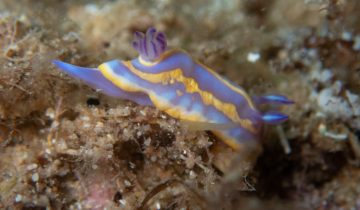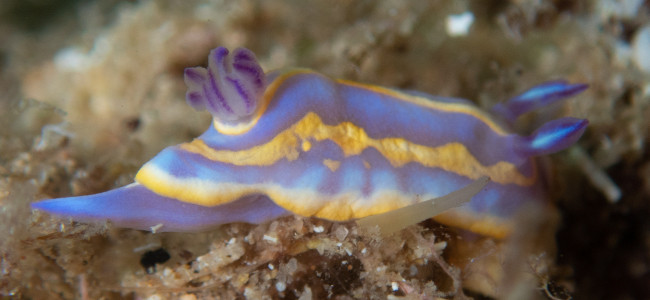Felimida binza, commonly known as the harlequin sea goddess, is a species of sea slug in the order Nudibranchia and family Chromodorididae. Although the exact origin of its specific name ‘binza‘ has not been explained by its authors, Ev. Marcus and Er. Marcus (1963), this species has undergone numerous taxonomic revisions and was known for years as Felimida britoi. It is currently recognized as a single species under the name Felimida binza. It is distributed throughout the eastern Atlantic — including the Canary Islands, Azores, Madeira, and the Cantabrian coast — and the Mediterranean Sea, being common in areas such as the Gulf of Naples, Sicily, and the Costa Brava. It inhabits rocky infralittoral bottoms down to about 20 meters deep, often found in well-lit areas, frequently under stones or among sponges.
With an elongated and somewhat oval body, Felimida binza can reach a maximum length of 30 mm. It displays a spectacular coloration, with a violet or bluish-purple background adorned by three longitudinal golden-yellow lines. The central line bifurcates in front of the rhinophores, surrounds the gills, and shows tone variations along the back. The lateral lines can be continuous, fragmented, or form patterns, and they join behind the branchial plume. The mantle edge is decorated with two bands: an inner white one and an outer yellow one. The rhinophores are the same color as the body, with a dark line on the anterior side and white pigmentation on the posterior; they have between 6 and 20 lamellae depending on the specimen’s size. The gills, arranged in a circle around the anal pore, are transparent with purple rachises. This species can be confused with Felimida krohni, but differs in the dorsal line arrangement: Felimida krohni has a white dorsal line and two lateral lines with dots, while Felimida binza lacks these features in the same pattern.
The feeding habits of Felimida binza are not fully documented, but like other family members, it mainly feeds on marine sponges. The sponge Chelonaplysilla erecta has been identified as part of its diet. In its natural habitat, it is commonly found on rocky substrates colonized by sponges, indicating a close trophic relationship. Consuming these sponges not only provides nourishment but also chemical compounds that it uses for chemical defense.
Felimida binza reproduces mainly during spring and summer. As with most nudibranchs, it is a simultaneous hermaphrodite: each individual possesses functional male and female reproductive organs. Fertilization occurs through reciprocal copulation, where animals position themselves in opposite directions and exchange sperm. The egg laying consists of a semi-transparent spiral ribbon about 20 mm in diameter, containing white eggs arranged in double rows of 9 to 10 eggs each.
Among its defensive adaptations, Felimida binza has marginal defensive glands (MDGs) along the mantle edge, except in front of the rhinophores. These glands release small viscous spheres when disturbed, a mechanism used to deter predators. These glands contain secondary metabolites—likely derived from the sponges it consumes—such as diterpenoids. Another interesting fact is that until recently, the taxonomy of this species was debated: after recent molecular studies, it has been confirmed that Felimida britoi and Felimida binza are in fact the same species. Nevertheless, it can still be found referenced under its former name in some sources.
Photos:


